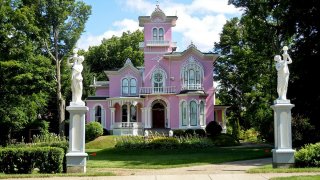
What to Know
- The state of New York is rich in history -- history that is still tangible thanks to the decades-old, or in some cases, century-old structures that are standing tall to this very day.
- Eighteen locations have been recommended by the New York State Board for Historic Preservation to be designated to the State and National Registers of Historic Places.
- Although the recommended locations are found throughout the state, there are several that are in New York City, Long Island and the Mid-Hudson region.
History is everywhere you look.
With that in mind, look no further than the rich history found throughout New York. History that is still tangible thanks to the decades-old, or in some cases, century-old structures that are standing tall to this very day.
Eighteen locations have been recommended by the New York State Board for Historic Preservation to be designated to the State and National Registers of Historic Places -- various of these are found in New York City, Long Island as well as the Mid-Hudson region.
"These historic locations highlight so much of what is exceptional about New York and its incredible contributions to our nation's history," Gov. Andrew Cuomo said in a statement. "By placing these landmarks on the State and National Registers of Historic Places, we are helping to ensure these places and their caretakers have the funding needed to preserve, improve and promote the best of this great state."
State and National Registers listing can assist owners in revitalizing properties, including by making them eligible for various public preservation programs and services, such as state grants and state and federal historic rehabilitation tax credits.
The State and National Registers are the official lists of buildings, structures, districts, landscapes, sites and more that are deemed significant in the history, architecture and culture of not only New York State, but also, and the nation.
News
According to New York officials, to date, there are more than 120,000 historic properties throughout the state listed on the National Register of Historic Places, individually or as components of historic districts. Property owners, municipalities and organizations from communities throughout the state sponsored the nominations.
Among the latest recommendations are an early home that reflects Long Island's African-American community, remnants of a 19th century canal that helped fuel the Southern Tier economy and offices of an internationally known upstate tableware company founded by a 19th century religious community.
These historic locations highlight so much of what is exceptional about New York and its incredible contributions to our nation's history.
New York Gov. Andrew Cuomo
The complete list of the locations recommended by the New York State Board for Historic Preservation to be designated to the State and National Registers of Historic Places is:
NEW YORK CITY
- Frederick Law Olmstead Sr. Farmhouse, located in Staten Island, Richmond County - The architect, writer and social critic lived in this home on the South Shore of Staten Island when he was a young man between 1848 and 1855. Olmstead is best known for designing Central Park and Prospect Park in Manhattan, as well as the Niagara Reservation, now known as Niagara Falls State Park.
LONG ISLAND
- Mary E. Bell House, located in Center Moriches, Suffolk County - This two-story frame house was built in 1872 by an African American family and reflects the history of Long Island's African American community. The home fell out of family ownership in the 1990s and was threatened with demolition in 2009 before the Town of Brookhaven took ownership. It is now a museum.
MID-HUDSON
- Rhinebeck Village Historic District Expansion, located in Rhinebeck, Dutchess County - An area with more than 250 buildings, sites and structures, this historic district expansion includes residential areas associated with the village's once-thriving violet growing industry as well as a neighborhood established for African American and Irish American residents. These areas were excluded when the district was originally listed in 1979. While the area's many violet greenhouses are now gone, the district still includes the grand former residences of major producers.
- Zion Episcopal Church, located in Dobbs Ferry, Westchester County - The church was constructed in the 1830s in the Gothic Revival style, and expanded in the 1850s and 1870s. It remains in use and is the oldest religious building in Dobbs Ferry.
CAPITAL DISTRICT
- Greenwich School District School No. 11, located Center Falls, Washington County - This one-room schoolhouse opened in this rural community in the 1850s to serve one of the mill hamlets that developed along the Battenkill River during the 19th century. The school closed in 1944 and is currently vacant.
CENTRAL NEW YORK
- Amboy District No. 2 Schoolhouse, located in East Amboy, Oswego County - This one-room schoolhouse was built in 1895 and served the region until 1952. The school was moved to its present location in the 1970s as part of a road project.
- Foster-Hubbard House, located in Syracuse, Onondaga County - Constructed in 1872, this Italianate-style house was designed and built by prominent local architect, builder, and industrialist Simon DeGraff.
- West Broadway Commercial Historic District, located in Fulton, Oswego County - This area features eight brick commercial buildings -- the only remaining of the city's late-19th century and early 20th century commercial architecture.
- Oneida Community Limited Administration Building, located in Oneida, Madison County - Originally built in 1926, the Collegiate Gothic-style commercial building was expanded in 1948 and again in 1965. It is associated with an internationally known manufacturer of silverware, cutlery, and tableware. The company was an outgrowth of the Oneida Community, a religious communal society established in Oneida in 1848 that subsequently dissolved in 1880 and became the silverware company Oneida Limited, which remains in business. Although manufacturing is now overseas, the company's administrative and corporate functions remain in Oneida.
FINGER LAKES
- George and Addison Wheeler House, located in East Bloomfield, Ontario County - Although this location was first listed on the National and State Register of Historic Places in 2005, the listing for this early 19th century residence and farm is being expanded in order to include a historic barn that was acquired.
- Hannah and George W. Jones House, located in Ovid, Seneca County - Built in 1873, this Italianate-style residence was originally constructed for a local wealthy couple, although the building was later used as a funeral home.
MOHAWK VALLEY
- Hildreth Homestead, located in Herkimer, Herkimer County - This farm property includes an Italianate-style home and barn that dates back to the 1860s.
NORTH COUNTRY
- Oval Wood Dish Factory, located in Tupper Lake, Franklin County - Built between 1916 and 1918, the former factory complex (business closed in 1967 following a warehouse fire) is an example of the woodworking industry in the Adirondacks in the early 20th century.
SOUTHERN TIER
- Chenango Canal, Towpath and Lock 106 (Walker's Lock), located in Chenango Forks, Chenango and Broome counties - This is a remaining 1.3-mile section of the Chenango Canal, built between 1834 and 1836, that once connected the Erie Canal at Utica to the Susquehanna River in Binghamton. The canal fueled the economy of the two counties until it closed in 1878 due to financial competition from the railroads.
WESTERN NEW YORK
- Lafayette Flats, located in Buffalo, Erie County - Constructed in 1897, the 36-unit Classical Revival-style apartment building provided housing to the city's growing middle class up until the time of World War II.
- Niagara Lithograph Company, located in Buffalo, Erie County - Built in 1903, this two-story brick printing plant reflects the city's role in the growth of the lithograph industry. After a merger, the plant continued to run until closing in 1992. In 2018-19, the vacant building was rehabilitated for use as apartments, offices, and health care related services.
- Our Mother of Good Counsel Roman Catholic Church Complex, located in Blasdell, Erie County - Dating from the early 1950s, this Gothic Revival style church, parochial school, and convent is one of the most intact representations of a mid-20th century church complex in the towns south of Buffalo.
- The Pink House, located in Wellsville, Allegany County - Built in 1866, this Italianate-style villa also includes intact historic-period features including marble statuary, an ice-house, a three-story carriage barn, a gazebo, and a building known as the Fossil House, where original owner Edwin P. Hall stored his extensive fossil collection that is now housed at the New York State Museum in Albany and the Carnegie Museum in Pittsburgh. The Pink House is still in family ownership and retains its original pink exterior color where its number derives from.
For more information, including photos of the nominations, visit the Office of Parks, Recreation and Historic Preservation website.
Pandemic-friendly, socially distant road trip anyone?



